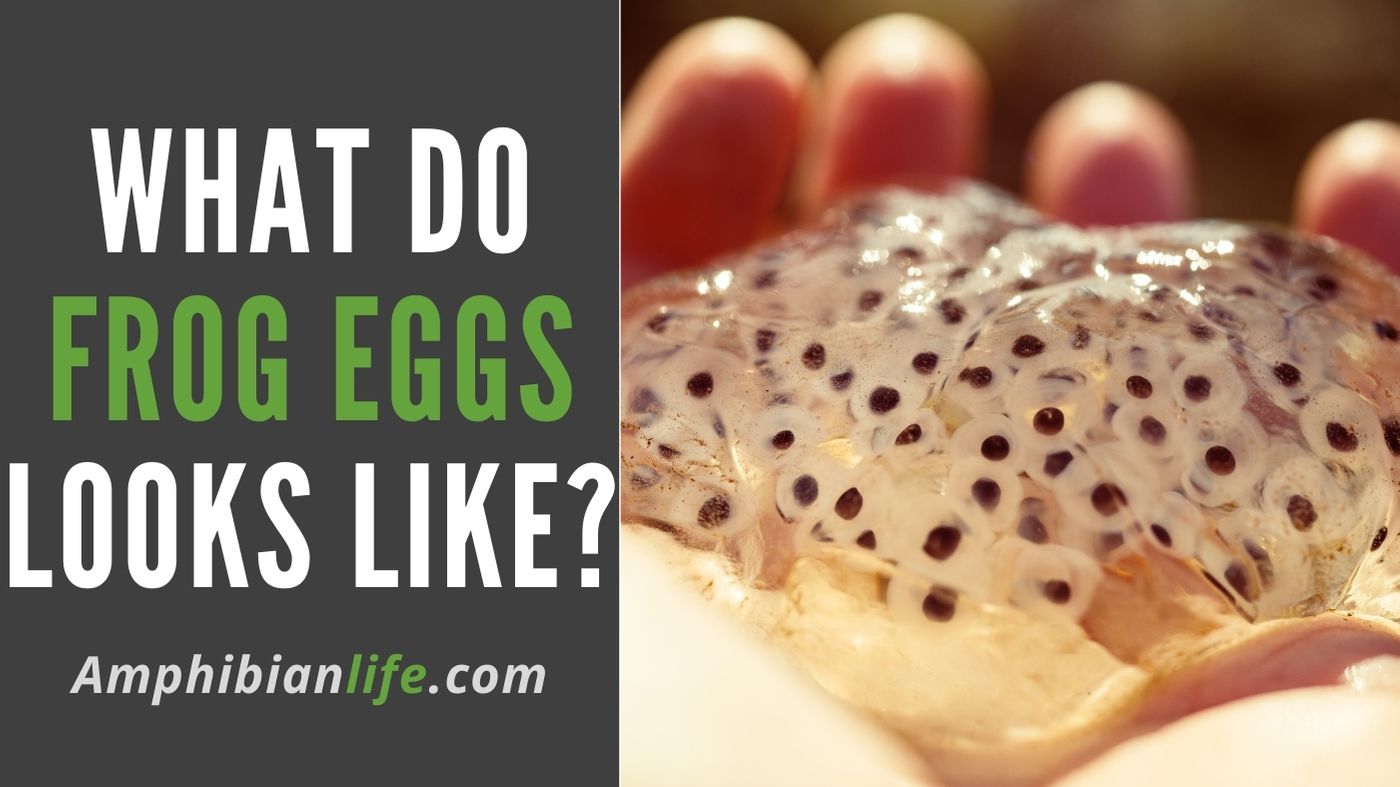
Did you ever wonder how frogs egg look in different situations? Then you came to the right place! In this article, I will try to show you what frog eggs look like in different situations so that you have an idea!
First, let’s begin with some regular information about frog eggs. What they consist of and where they are laid. This way you have a good understanding of it when we go further.
What Is a Frog Egg And What Is Inside it?
In the image below you see the first example of what frog eggs look like. As you can see there is a white mass around a black dot.
But what is in the center? These black dots are made up of cells that will eventually grow into a tadpole.
Now the jelly-like mass around the cells in the middle is also an interesting story.
The function of the jelly is to help the eggs stay moist so that they won’t dry out in the sun.
You can imagine that when the eggs are laid in a pond where the sun shines, that without a defense mechanism, the eggs would dry up in a matter of hours.
The jelly-like substance also offers some protection from predators.

Where Do Frogs Normally Lay Their Eggs?
Most of the time frogs lay their eggs in water. This is also to help the eggs to stay moist just as I said above.
There’s also another reason that frogs lay their eggs in water and that is because when they later hatch into tadpoles, the tadpoles feed themselves on the soft plants that are in the water and easy to eat.
Where Do Frogs Lay Their Eggs?
Frogs, fascinating creatures of the amphibian world, have developed diverse strategies for laying their eggs. These strategies are influenced by various factors, including their habitat, species-specific adaptations, and the prevailing environmental conditions. Let’s embark on a journey to explore the fascinating world of frog egg-laying:
Aquatic Environments:
- Frogs in ponds and lakes: Many frog species lay their eggs directly in the water, often forming large, gelatinous masses known as frog spawn. These masses are typically attached to submerged plants or rocks, providing a protective environment for the developing eggs.
- Frogs in streams and rivers: Some frog species, particularly those inhabiting fast-flowing streams and rivers, lay their eggs in jelly-like strings or clumps that are attached to submerged rocks or vegetation. This ensures that the eggs are not swept away by the current.
Terrestrial Environments:
- Frogs on land: A few frog species lay their eggs on land, often in moist, shaded areas. These eggs may be laid in small clusters or individually.
- Frogs in burrows: Some frogs create burrows in the ground or utilize existing burrows of other animals to lay their eggs. This provides a sheltered environment for the developing eggs, protecting them from predators and desiccation.
Specialized Adaptations:
- Foam nests: Some frog species build foam nests, which are structures made of frothy mucus secreted by the male frog. The eggs are laid within the foam nest, providing a protective and humid environment.
- Back pouches: A few frog species have specialized pouches on their backs where they carry their eggs. This allows them to protect the eggs from predators and adverse environmental conditions.
- Leaf litter: Some frog species lay their eggs in leaf litter, where they are camouflaged and protected from predators.
Factors Influencing Egg-Laying Behavior:
- Temperature: Frogs are ectothermic animals, meaning their body temperature is regulated by the environment. Temperature plays a crucial role in determining the timing and location of egg-laying.
- Water quality: The quality of water is essential for the survival of frog eggs and tadpoles. Frogs often select habitats with clean, oxygenated water.
- Predation pressure: The risk of predation from other animals can influence where frogs choose to lay their eggs. Some species may opt for more secluded or hidden locations to protect their offspring.
- Species-specific adaptations: Different frog species have evolved unique adaptations for egg-laying, allowing them to thrive in diverse habitats.
The Importance of Frog Eggs:
Frog eggs play a vital role in the life cycle of amphibians. They are the first stage of development, and their survival is essential for the continuation of frog populations. Understanding the diverse strategies that frogs employ for egg-laying helps us appreciate the complexity and resilience of these fascinating creatures.
By studying frog egg-laying behavior, scientists can gain insights into the reproductive strategies of amphibians and the factors that influence their population dynamics. This knowledge is crucial for conservation efforts and the protection of these valuable species.

Now that is not the whole story… Some frogs do it quite differently.
There are frogs for example where when the female frog pop out the eggs, the male grasps those eggs with his hind feet and pushes them onto the back of the female frog.
On the back of the female frog is a sort of pouch where the eggs have optimal conditions to become tadpoles.

Frog lay eggs on their back
Now other frogs will breed only a couple of eggs and adhere them on their back instead of a few thousand as you can read it this article I wrote (here is the article about how many eggs frogs lay).
They do this because of “parental care” and can somewhat assure that the eggs are sage and make it through the hatching stage.
Frogs are amphibians that reproduce through a process called amplexus, where the male mounts the female and fertilizes her eggs as she lays them. The location where frogs lay their eggs varies greatly depending on the species and their specific habitat.
5 Common locations for frog egg laying include:
- Water bodies: The most common location for frog eggs is in water. This can include ponds, lakes, rivers, streams, and even temporary puddles. The water provides a suitable environment for the eggs to develop and hatch into tadpoles.
- Aquatic plants: Many frog species lay their eggs on aquatic plants, which provide a secure and protected environment for the eggs.
- Floating rafts: Some frog species create floating rafts of plant material and lay their eggs on top of them. These rafts provide a safe and stable environment for the eggs to develop.
- Foam nests: Some frogs, like the Darwin’s frog, create foam nests in which they lay their eggs. The foam nest provides a protective environment for the eggs and tadpoles.
- On land: A few frog species, such as the Darwin’s frog and the Surinam toad, lay their eggs on land. The eggs are then carried by the male or female frog until they hatch.
The specific location where a frog lays its eggs depends on a variety of factors, including the species, the availability of suitable habitats, and the environmental conditions. However, all frogs lay their eggs in moist, aquatic environments that provide the necessary conditions for their development.
